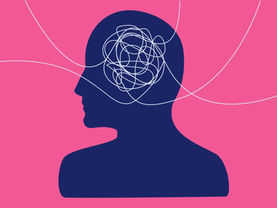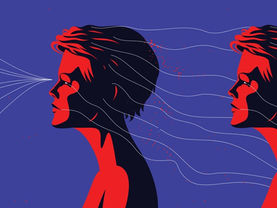Wired Differently
- Michelle Ossai

- Jun 8
- 4 min read
Why Neurodivergent Brains Aren’t Broken
By Michelle Ossai
“Why can’t you just focus?”
“You talk too much.”
“You’re awfully sensitive. It’s low-key annoying.”
Do these harsh remarks sound familiar? Do they set off an uncomfortable process that leads to not-so-enjoyable memories? Maybe it’s time to stop asking what’s wrong with you—and start understanding what’s different about you.
So, What Is Neurodivergence?
Neurodivergence means that your brain processes the world differently than what’s considered “typical.” It’s not an illness. It’s not a disorder that needs “fixing.” It’s just a different wiring of the brain.
Neurodivergent conditions include:
ADHD – You might find it hard to focus, but you’re also incredibly creative and fast-thinking.
Autism – You may experience the world in a more intense, deep, or structured way. Socializing might be hard—but your passions can shine.
Dyslexia – Reading or writing can be a challenge, but your brain might be excellent at visual thinking or storytelling.
Tourette’s, OCD, Dyspraxia, Sensory Processing Differences – all valid forms of neurodivergence.
The Science Behind It
Morphologically (structurally), neurodivergent brains show structural variations in comparison to their neurotypical counterparts. These differences are not indicative of dysfunction, but rather, reflect the diversity in human neuroanatomy. Let’s break it down for Autism, Dyslexia, and ADHD.
In Autism, the amygdala (a brain region involved in processing emotions and social interactions) could be enlarged, contributing to the heightened sensitivity to emotional stimuli. This doesn’t make it okay for the people around you to make insensitive remarks and blame you for a reaction. The cerebellum (which plays a role in motor control and coordination) may also show structural differences in neurodivergent individuals. The cerebellum may be smaller or have abnormal connections with other brain regions. Additionally, there are altered serotonin and dopamine levels. These neurotransmitters are involved in mood regulation, social behavior, and sensory processing. Oxytocin, the "bonding hormone," may also be at atypical levels, influencing social interactions and empathy. Autistic individuals may rely more heavily on structured routines or specialized interests to make sense of the world, which may engage different brain circuits than those typically used by neurotypical individuals.
Individuals with ADHD may have a smaller prefrontal cortex (the area involved in attention, executive functions, and impulse control). Also, there may be differences in the basal ganglia (involved in motor control and reward processing), contributing to issues with attention and impulse regulation. Dopamine dysregulation is the hallmark of ADHD. Dopamine is involved in reward processing and attention. In ADHD, there is often an insufficient amount of dopamine in key brain regions like the prefrontal cortex and basal ganglia, making it harder to maintain attention or regulate impulses. Norepinephrine, a neurotransmitter involved in arousal and alertness, is also often dysregulated in ADHD. Still, People with ADHD might develop highly creative, fast-paced problem-solving techniques to navigate their environment, often leveraging their unique cognitive flexibility.
Dyslexic individuals often have differences in the left hemisphere of the brain, particularly the temporal and parietal lobes, areas that are involved in language processing and reading. Broca's area (speech production) and Wernicke’s area (language comprehension) can show altered activity in dyslexia, affecting how words are processed. Dopamine and glutamate (excitatory neurotransmitters) can show altered levels in dyslexic brains, affecting learning and memory processes. Differences in the cortical dopamine system may impair the ability to focus and decode written words. Dyslexic individuals often develop strengths in areas like problem-solving, creativity, and spatial reasoning as compensatory mechanisms. Many individuals with dyslexia excel in tasks that involve spatial thinking, such as visualizing objects, solving puzzles, or understanding complex systems. This is because dyslexia often comes with differences in brain wiring that enhance the brain's ability to perceive and manipulate objects in space.
Why This Matters in Your Teenage Years
As teenagers, we’re often already misunderstood—but for neurodivergent teens, it can feel like the world is just not built for you. It can feel like its poor infrastructure is crashing down on your head.
The truth is: your brain is still developing—especially the prefrontal cortex, which handles things like decision-making, attention, impulse control, and emotions. For neurodivergent teens, this development can look different, not wrong. Humans are terrible at stepping out of their comfort zone and they can hate viewing things differently. Step forward anyway and provide a new lens.
You Are Not Alone
1 in 5 people is neurodivergent in some way. That means there are millions of teens across the world who stim, fidget, need quiet spaces, or struggle with “simple” tasks. And most of them are trying to survive in schools, homes, and social circles that don’t fully understand them yet.
Let’s Flip the Script. Neurodivergent doesn’t mean “deficient.” It often means:
Thinking outside the box
Noticing what others miss
Hyperfocus (which can feel like a superpower)
Emotional depth and strong empathy
Original ideas, art, and solutions
Yes, challenges exist. But so do strengths. You don’t need to be “fixed”—you need to be supported.
How to Embrace the Way You’re Wired
1. Stop comparing. Your brain isn’t a glitchy version of someone else’s. It’s its own unique design.
2. Use your strengths. Whether it’s visual memory, intense focus, or pattern recognition—find what makes your brain awesome.
3. Set boundaries. It’s okay to need quiet, routine, or time alone. Your needs are real.
4. Educate others. You don’t owe anyone an explanation—but sharing can help break stigma.
5. Find your people. Online communities, support groups, and even friends who “get it” can make a huge difference.
All-In-All
You’re not a problem to be solved. You’re not lazy. You’re not broken. You’re not “too much.” Some humans just aren't fond of using extra cognitive energy. In a world that desperately needs new ideas, bold creativity, and big feelings—you might be exactly what it needs.
What if every human on this Earth had the same face? The same hair? The same height? The same views? Uncanny, right? It’s no less uncanny if we all had the same brain. So, no. You don’t have a disorder. Your brain is just differently ordered. It doesn’t make you less than your neurotypical peers. Let’s look back to Dr. Seuss. "Why try to fit in when you were born to stand out?”















Date to be different in a world predominantly ordinary. Brilliant!
Good job dear Michelle - weldone